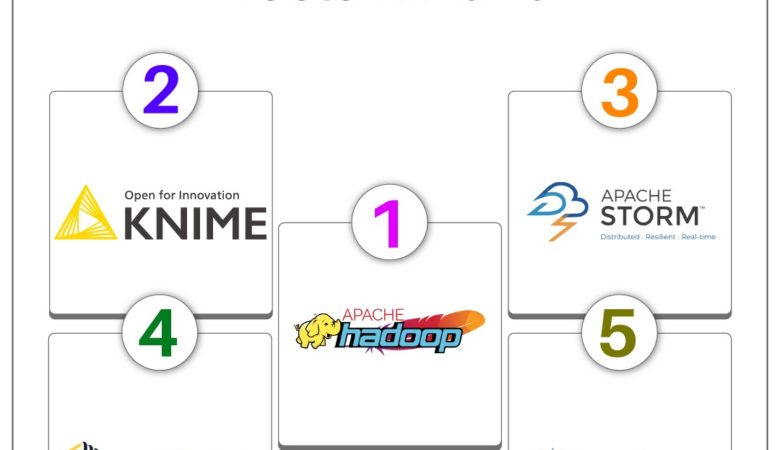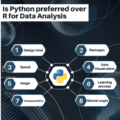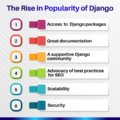
As per the Python Software Foundation’s 2018 developer survey, based on responses from 24,000 Python developers from 150 countries Python is used by 59% of respondents for data analysis, and 52% said that they used it for web development. It solves data science tasks and challenges and is an easy-to-learn, object-oriented, easy-to-debug, having a wide usage, besides being open-source, and giving a high-performance. Python libraries are used by programmers in a big way to solve problems.
Let us learn about the Top 5 Python Libraries for Data Science
1. TensorFlow
TensorFlow is a library that has 1,500 contributors and carries out for high-performance numerical computations resulting in 35,000 comments. It has a framework to define and run computations that involve tensors that are partially defined computational objects eventually producing a value. Its features are:
- Fine computational graph visualizations
- Reduction of error by 60 percent in neural machine learning
- Parallel computing making the execution of complex models easy
- Great library management supported by Google
- Quick updates and many new releases providing the latest features
It is useful in applications of:
- Speech and image recognition
- Time-series analysis
- Text-based applications and finally
- Video detection
2. NumPy
It is a general-purpose package dealing with array-processing. It provides fast functions for numerical routines and supports an object-oriented approach. A powerful feature is compact and fast computations with vectorization
It gives high-performance, multidimensional array objects as well as tools to work. It is efficient, and a container of generic multi-dimensional data in an efficient way. It is a table of numbers of similar data types, having the index by a tuple of positive integers. It is used for processing arrays that store values of the same data type also facilitating math operations on arrays. There is enhanced performance and quick execution in it.
We can do the following with NumPy
1. Basic array operations like adding, multiplying, slicing, flattening, reshaping, and index arrays
2. Advanced array operations like stack arrays, splitting into sections, and broadcasting arrays
3. Working with Linear Algebra
4. Basic Slicing/ Advanced Indexing
Also known as Numerical Python it has a powerful N-dimensional array object. Additionally, it received 18,000 comments on GitHub and has an active community comprising 700 contributors.
A major Application is its extensive use in data analysis. It forms the base of other libraries, like SciPy and scikit-learn
3. SciPy
SciPy builds on the NumPy array object and uses it significantly. It is an inherent part of the stack which includes Matplotlib, Pandas, and SymPy,
In this library there are modules for efficient mathematical routines covering linear algebra, optimization, interpolation, calculus, integration, and statistics, besides ordinary differential equations, and signal processing. SciPy or the Scientific Python is a free and open-source Python library extensively used in data science for high-level computations. It has 19,000 comments on GitHub and is served by an active community of 600 contributors. It is used for scientific/technical computations and is user-friendly providing efficient routines for scientific calculations.
Features:
- It is a collection of algorithms and functions with a structure of the NumPy extension in Python
- It provides High-level commands to help in data manipulation /visualization
- It can process Multidimensional images
- It has built-in functions to solve differential equations
- Its Applications can be used in Multidimensional image operations and to solve differential equations plus has Optimization algorithms and Linear algebra
4. Pandas
It is an open-source Python package which provides top performance, and has easy-to-use data structures. Pandas is the finest tool for data wrangling. The data manipulation, aggregation, reading, and visualization is easy in it.
Pandas collect data in a CSV/ TSV file or in the SQL database leading to creation of a Python object having rows and columns called the data frame that is similar to a table in statistical software.
Tasks that it can do are:
1. Indexing, renaming, manipulating, sorting, and merging data frame
2. Updating, Adding, Deleting columns in the data frame
3. Imputing missing files, or handling the missing data
4. Plotting data with histogram
It is also a foundation library to learn Python for Data Science and is popular with the professionals and has 1700 comments on GitHub supported by an active community of 1,200 contributors. Additionally, it provides fast and flexible data structures, which are designed to work quickly with structured data.
Its prominent Features are:
- Eloquent syntax and efficient functionalities that offer freedom in dealing with missing data
- One can create a function and run it across a series of data
- There is a great degree of abstraction in it
- Offers high-level data structures and manipulation tools
Applications:
- General data wrangling and cleaning as well as extracting, transforming, and loading jobs for data transformation is easy in it.
- It supports loading CSV files in its data frame format
- There is extensive use in statistics, finance, and neuroscience
5. Matplotlib
Matplotlib has 26,000 comments on GitHub and the community support of 700 contributors. On the strength of graphs and plots that it offers great use in data visualization. Also, there is an object-oriented API, for embedding those plots into applications.
Features:
- It is free and open-source and supports many back ends and output types. Finally, there is Low memory consumption leading to the better runtime behavior
- There are Applications like Correlation analysis of variables
- Finest Visualization and Outlier detection by using a scatter plot
Conclusion
With these features and applications, these top five Python Libraries are useful and meet the requirements of the users in a big way.








Leave a Reply